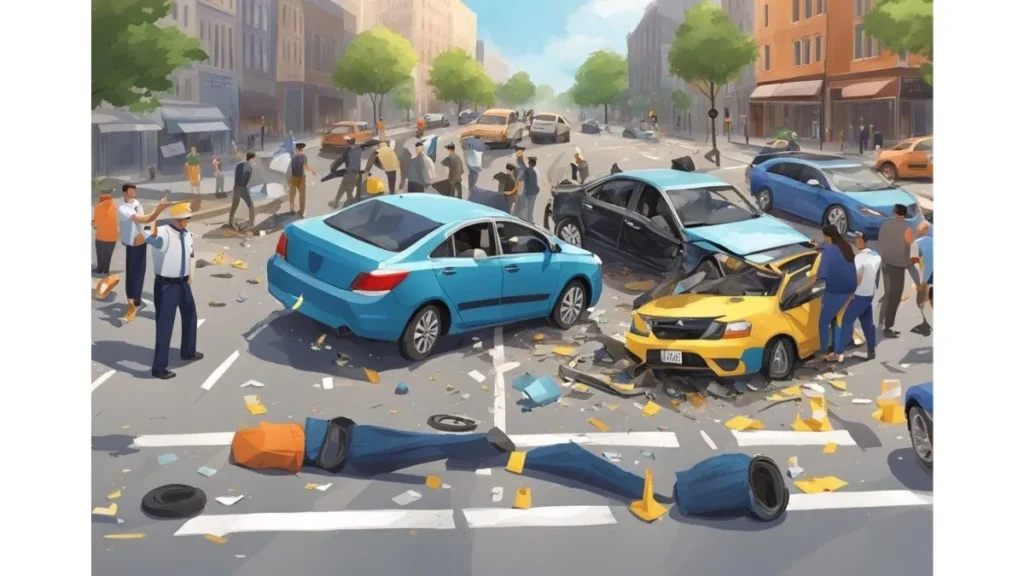Car accidents can be devastating and can result in serious injuries, property damage, and emotional distress. Understanding car accident laws is crucial for both drivers and passengers and professionals like Baltimore car accident lawyers can help you navigate the legal process if you are involved in an accident.
Filing a police report promptly after a car accident is crucial as it documents vital details and helps build a solid case. Law enforcement officers contribute significantly by investigating and collecting evidence for your claim.
It’s also essential to understand the varying laws and deadlines in each state for filing a car accident lawsuit, known as the statute of limitations. Timely filing of a claim with your or the responsible party’s insurance is necessary to protect your legal rights and secure deserved compensation.
Contents
Identifying Fault and Liability
In the event of a car accident, determining fault and liability is crucial. Fault refers to the party or parties responsible for causing the accident, while liability refers to the legal responsibility for the damages resulting from the accident.
In most cases, fault is determined by examining the actions of the drivers involved in the accident. A driver who fails to obey traffic laws, drives recklessly, or is distracted while driving may be considered negligent, and therefore at fault for the accident.
However, fault can also be attributed to other factors such as poor road conditions, vehicle defects, or even weather conditions. In such cases, determining fault may be more complex and require the expertise of accident reconstruction specialists.
Once fault has been established, liability comes into play. The party at fault may be held liable for damages resulting from the accident, including property damage, medical expenses, lost wages, and pain and suffering.
In some cases, liability may be shared between multiple parties. This is known as comparative negligence, and it means that each party is assigned a percentage of fault based on their contribution to the accident. For example, if a driver is found to be 70% at fault for an accident, they may be responsible for 70% of the damages.
It is important to note that admitting fault at the scene of an accident may have legal consequences. It is recommended that drivers involved in an accident do not admit fault, but rather exchange contact and insurance information and allow the insurance companies to determine fault.
Having liability insurance is also crucial in the event of an accident. Liability coverage can help cover the costs of damages and injuries resulting from an accident for which the driver is found to be at fault.
Role of Insurance in Car Accidents
In a car accident, insurance plays a crucial role in determining the outcome of the situation. Insurance is a financial product that provides coverage for damages and injuries caused by a car accident. It is mandatory in most states for drivers to carry a minimum amount of liability insurance to cover damages caused to other parties in the event of an accident.
The insurance company is responsible for assessing the damages and injuries caused by the accident and determining the amount of compensation that is due to the parties involved. The insurance company will also investigate the accident to determine who was at fault and whether any laws were broken.
In the event of an accident, the parties involved can file an insurance claim with their insurance company. The insurance company will then investigate the claim and determine the amount of compensation that is due to the parties involved. It is important to note that insurance claims can take time to process, and the amount of compensation can vary depending on the circumstances of the accident.
Uninsured motorist coverage and underinsured motorist coverage are also important types of insurance coverage to consider. Uninsured motorist coverage provides coverage for damages and injuries caused by a driver who does not have insurance. Underinsured motorist coverage provides coverage for damages and injuries caused by a driver who has insurance, but the amount of coverage is not enough to cover all of the damages and injuries caused by the accident.
Personal injury protection is another type of insurance coverage that is important to consider. Personal injury protection provides coverage for medical expenses and lost wages that are incurred as a result of a car accident, regardless of who was at fault for the accident.
Legal Proceedings Following a Car Accident
After a car accident, legal proceedings may follow to determine fault and damages. These proceedings can involve a lawsuit, court, jury, judge, trial, and settlement negotiations. Understanding the legal landscape and the steps involved in legal action can help individuals involved in a car accident navigate the process.
The first step in legal proceedings is determining liability. This involves establishing fault for the accident, which depends significantly on evidence, including witness statements, police reports, and occasionally expert opinions. Once liability is determined, the case may proceed to settlement negotiations or a lawsuit.
If a lawsuit is filed, the case will go to court, where a judge and jury will hear the evidence presented by both parties. The jury will then determine the outcome of the case, including any damages awarded to the plaintiff. It is important to note that not all car accident cases go to trial, as many are settled out of court through negotiations between the parties involved.
During settlement negotiations, the parties involved may attempt to reach a resolution without going to trial. This can involve negotiating a settlement amount to compensate the injured party for damages such as medical expenses, lost wages, and pain and suffering.
Conclusion

Knowledge is power when it comes to understanding car accident laws. A comprehensive guide can help you navigate the legal process if you are involved in an accident. Here are some key takeaways from this guide:
- After an accident, it is crucial to exchange information with the other driver and contact your insurance company.
- Filing a police report is essential to document key details such as the date, time, location, involved parties, and initial liability assessment.
- Understanding car accident liability is vital for anyone who finds themselves entangled in such an unfortunate event. It helps ascertain responsibility for the accident and directs the process of obtaining just compensation for damages.
- Victims of car accidents have rights and can seek compensation for damages incurred. Consulting with an experienced attorney can help victims navigate the legal system and get the compensation they deserve.
Overall, it is important to stay calm and collected after a car accident and to follow the necessary steps to ensure your safety and protect your rights. With the right knowledge and guidance, you can navigate the legal process and obtain just compensation for damages incurred.











